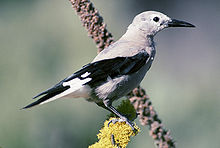Clark's Nutcracker
|
Nucifraga columbiana Clark's nutcracker |
|
|---|---|
 |
|
| In Deschutes National Forest | |
| Scientific classification | |
| Kingdom: | Animalia |
| Phylum: | Chordata |
| Class: | Aves |
| Order: | Passeriformes |
| Family: | Corvidae |
| Genus: | Nucifraga |
| Species: | N. columbiana |
| Binomial name | |
|
Nucifraga columbiana (Wilson, 1811) |
|
Clark's nutcracker (Nucifraga columbiana), sometimes referred to as Clark's crow or woodpecker crow, is a passerine bird in the family Corvidae. It is slightly smaller than its Eurasian relative the spotted nutcracker (N. caryocatactes). It is ashy-grey all over except for the black-and-white wings and central tail feathers (the outer ones are white). The bill, legs and feet are also black. This bird derives its name from the explorer William Clark.
It can be seen in western North America from British Columbia and western Alberta in the north to Baja California and central New Mexico in the south. There is also a small isolated population on the peak of Cerro Potosí, elevation 3,700 metres (12,200 ft), in Nuevo León, northeast Mexico. It is mainly found in mountains at altitudes of 900–3,900 metres (3,000–12,900 ft) in conifer forest. Outside the breeding season, it may wander extensively to lower altitudes and also further east as far as Illinois (and exceptionally, Pennsylvania), particularly following any cone crop failure in its normal areas.
The most important food resources for this species are the seeds of pines (Pinus sp.), principally the two cold-climate (high altitude) species of white pine (Pinus subgenus Strobus) with large seeds P. albicaulis and P. flexilis, but also using other high-altitude species like P. balfouriana, P. longaeva and P. monticola. During migrations to lower altitudes, it also extensively uses the seeds of pinyon pines. The isolated Cerro Potosí population is strongly associated with the local endemic Potosi pinyon Pinus culminicola. All Clark's Nutcrackers have a sublingual pouch capable of holding around 50–150 seeds, depending on the size of the seeds; the pouch greatly enhances the birds' ability to transport and store seeds.
...
Wikipedia

